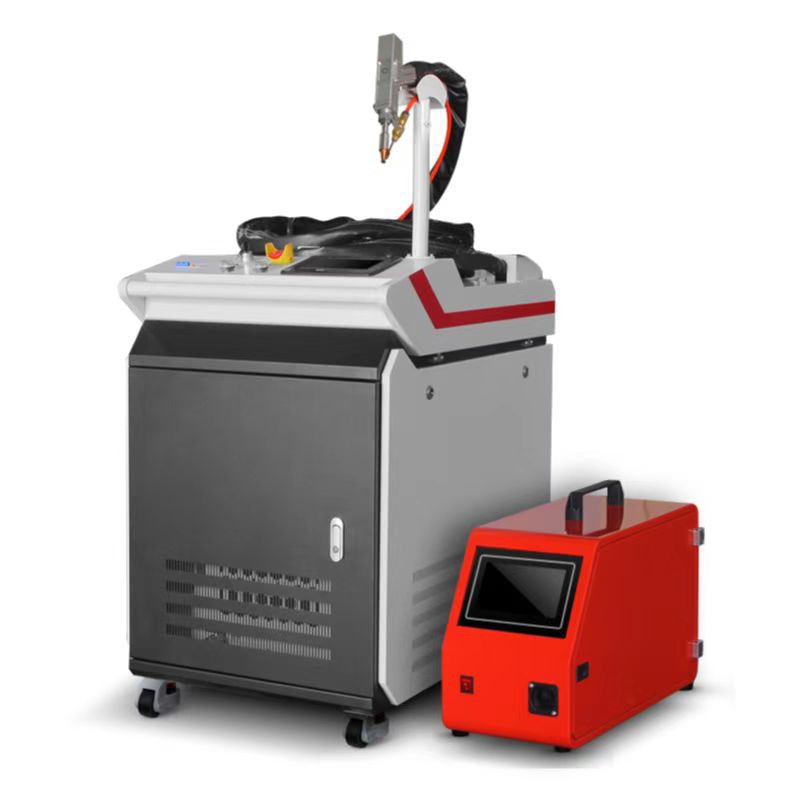Blog
Before the 1970s, because the high power continuous waveform (CW) laser has not been developed, the research focus is on pulsed laser welding (PW). Most of the early laser welding experiments used ruby pulse laser. The typical peak output power of 1ms pulse is about 5KW, the pulse energy is 1~5J, and the pulse frequency is less than or equal to 1 Hz. At that time, although they can live a higher pulse energy, but the average output power P of these lasers is quite low, which is mainly determined by the laser's very low efficiency and the excited properties of the luminous material. Laser because of its high average power, after its appearance soon became the preferred equipment for spot welding and seam welding, the welding process is carried out through the welding spot lap, until the birth of more than 1KW continuous power waveform laser seam welding with real significance can be realized.

What are the main application areas
Manufacturing industry
Laser welding technology has been widely used in foreign car manufacturing. According to statistics, there were more than 100 laser welding production lines for cutting blank plates worldwide in 2000, with an annual output of 70 million pieces of blank plates for car components, and it continues to grow at a high speed. Domestic production introduced models also use some cutting blank plate structure. In Japan, CO2 laser welding is used to replace flash butt welding for the connection of rolled steel coils in the steel making industry. In the study of ultra-thin plate welding, for example, foils with plate thickness of less than 100 microns cannot be fused, but YAG laser welding with special output power waveform is successful, which shows the broad prospect of laser welding. For the first time in the world, Japan has successfully developed YAG laser welding for the maintenance of steam generator tubes in nuclear reactors, and has also developed laser welding technology for gears in Japan.
Powder metallurgy
With the continuous development of science and technology, many industrial technology on the material special requirements, the application of smelting method of manufacturing materials can not meet the needs. Due to the special performance and manufacturing advantages of powder metallurgy materials, in some fields such as automobiles, aircraft, tools and cutting tools manufacturing is replacing the traditional smelting materials, with the growing development of powder metallurgy materials, it and other parts of the connection problem is increasingly prominent, so that the application of powder metallurgy materials is limited. In the early 1980s, laser welding entered the field of powder metallurgy materials processing with its unique advantages, opening up a new prospect for the application of powder metallurgy materials. For example, the welding of diamond by brazing method commonly used in the connection of powder metallurgy materials, due to low bonding strength, wide heat-affected zone, especially unable to adapt to high temperature and high strength requirements, the solder will melt and fall off. Laser welding can improve the welding strength and high temperature resistance.
Automobile industry
In the late 1980s, kilowatt laser was successfully used in industrial production, and now laser welding production line has appeared in the automobile manufacturing industry on a large scale, becoming one of the outstanding achievements of the automobile manufacturing industry. As early as the 1980s, European automobile manufacturers took the lead in using laser welding of roof, body, side frame and other sheet metal welding. In the 1990s, the United States introduced laser welding into automobile manufacturing. Although it started late, it developed quickly. Italy uses laser welding in the welding assembly of most steel plate components, and Japan uses laser welding and cutting processes in the manufacturing of body covering parts. High-strength steel laser welding assembly parts are being used more and more in the manufacturing of automobile bodies because of their excellent performance. According to the statistics of American Metal Market, by the end of 2002, Laser welded steel structure consumption will reach 70000t compared to 1998 increased 3 times. According to the characteristics of large batch and high degree of automation in automobile industry, laser welding equipment is developing to the direction of high power and multi-channel. In terms of technology, Sandia National Laboratory in the United States and PrattWitney jointly carried out the research of adding powder metal and wire in the laser welding process. The Institute of Applied Beam Technology in Bremen, Germany, carried out a lot of research in the laser welding of aluminum alloy body frame, and believed that adding filler in the weld is helpful to eliminate hot cracks. Improve the welding speed, solve the tolerance problem, the development of the production line has been put into production in the factory.
Electronics industry
Laser welding has been widely used in electronic industry, especially in microelectronic industry. Due to the small heat affected zone, rapid heating concentration and low thermal stress, laser welding has shown unique advantages in the packaging of integrated circuits and semiconductor device shells. In the development of vacuum devices, laser welding has also been applied, such as molybdenum focusing pole and stainless steel support ring, fast hot cathode filament components, etc. The thickness of the elastic thin wall corrugated sheet in the sensor or temperature controller is 0.05-0.1mm, which is difficult to be solved by the traditional welding method. TIG welding is easy to be penetrated, the plasma stability is poor, and the laser welding effect is very good and has been widely used.
Biomedical science
The laser welding of biological tissues began in the 1970s. The successful welding of fallopian tubes and blood vessels with laser welding and the advantages shown made more researchers try to weld various biological tissues, and extended to the welding of other tissues. The domestic and foreign researches on laser welding of nerves mainly focus on laser wavelength, dose, function recovery and selection of laser solder, etc. Liu Tongjun conducted basic research on laser welding of small blood vessels and skin, and then conducted welding research on the common bile duct of rat. Compared with the traditional suture method, laser welding has the advantages of fast anastomosis, no foreign body reaction in the healing process, maintaining the mechanical properties of the welding site, and the repaired tissue growth according to its original biomechanical properties, which will be more widely used in biomedicine in the future.
Other fields
In other industries, laser welding is also gradually increasing, especially in the welding of special materials, many domestic studies have been carried out, such as the laser welding of BT20 titanium alloy, HEl30 alloy, Li-ion battery and so on. Germany has developed a new laser welding technology for plate glass.







